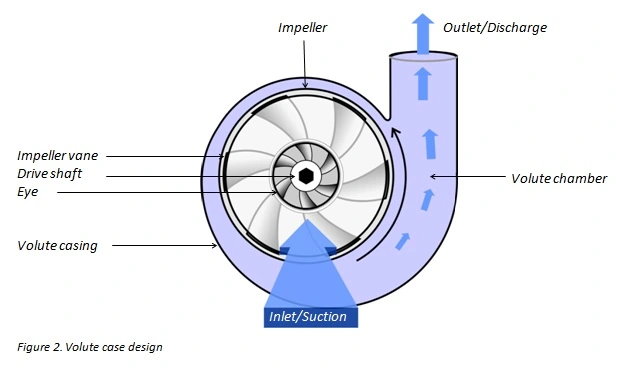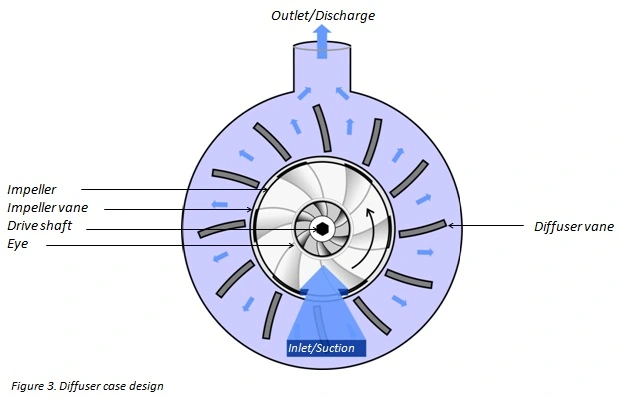How does a centrifugal pump work?
A centrifugal pump is a mechanical device designed to move a fluid by means of the transfer of rotational energy from one or more driven rotors, called impellers. Fluid enters the rapidly rotating impeller along its axis and is cast out by centrifugal force along its circumference through the impeller's vane tips. The action of the impeller increases the fluid's velocity and pressure and also directs it towards the pump outlet. The pump casing is specially designed to constrict the fluid from the pump inlet, direct it into the impeller and then slow and control the fluid before discharge.
How does a centrifugal pump work?
The impeller is the key component of a centrifugal pump. It consists of a series of curved vanes. These are normally sandwiched between two discs (an enclosed impeller). For fluids with entrained solids, an open or semi-open impeller (backed by a single disc) is preferred (Figure 1).

Fluid enters the impeller at its axis (the 'eye') and exits along the circumference between the vanes. The impeller, on the opposite side to the eye, is connected through a drive shaft to a motor and rotated at high speed (typically 500-5000rpm). The rotational motion of the impeller accelerates the fluid out through the impeller vanes into the pump casing.
There are two basic designs of pump casing: volute and diffuser. The purpose in both designs is to translate the fluid flow into a controlled discharge at pressure.
In a volute casing, the impeller is offset, effectively creating a curved funnel with an increasing cross-sectional area towards the pump outlet. This design causes the fluid pressure to increase towards the outlet (Figure 2).


What are the main features of a centrifugal pump?
There are two main families of pumps: centrifugal and positive displacement pumps. In comparison to the latter, centrifugal pumps are usually specified for higher flows and for pumping lower viscosity liquids, down to 0.1 cP. In some chemical plants, 90% of the pumps in use will be centrifugal pumps. However, there are a number of applications for which positive displacement pumps are preferred.
What are the limitations of a centrifugal pump?
The efficient operation of a centrifugal pump relies on the constant, high speed rotation of its impeller. With high viscosity feeds, centrifugal pump become increasingly inefficient: there is greater resistance and a higher pressure is needed to maintain a specific flow rate. In general, centrifugal pumps are therefore suited to low pressure, high capacity, pumping applications of liquids with viscosities between 0.1 and 200 cP.
Slurries such as mud, or high viscosity oils can cause excessive wear and overheating leading to damage and premature failures. Positive displacement pumps often operate at considerably lower speeds and are less prone to these problems.
Any pumped medium that is sensitive to shearing (the separation of emulsions, slurries or biological liquids) can also be damaged by the high speed of a centrifugal pump's impeller. In such cases, the lower speed of a positive displacement pump is preferred.
A further limitation is that, unlike a positive displacement pump, a centrifugal pump can not provide suction when dry: it must initially be primed with the pumped fluid. Centrifugal pumps are therefore not suited to any application where the supply is intermittent. Additionally, if the feed pressure is variable, a centrifugal pump produces a variable flow; a positive displacement pump is insensitive to changing pressures and will provide a constant output. So, in applications where accurate dosing is required, a positive displacement pump is preferred.
Summary
A centrifugal pump operates through the transfer of rotational energy from one or more driven rotors, called impellers. The action of the impeller increases the fluid's velocity and pressure and directs it towards the pump outlet. With its simple design, the centrifugal pump is well understood and easy to operate and maintain.
Centrifugal pump designs offer simple and low cost solutions to most low pressure, high capacity pumping applications involving low viscosity fluids such as water, solvents, chemicals and light oils. Typical applications involve water supply and circulation, irrigation, and the transfer of chemicals in petrochemical plants. Positive displacement pumps are preferred for applications involving highly viscous fluids such as thick oils and slurries, especially at high pressures, for complex feeds such as emulsions, foodstuffs or biological fluids, and when accurate dosing is required.